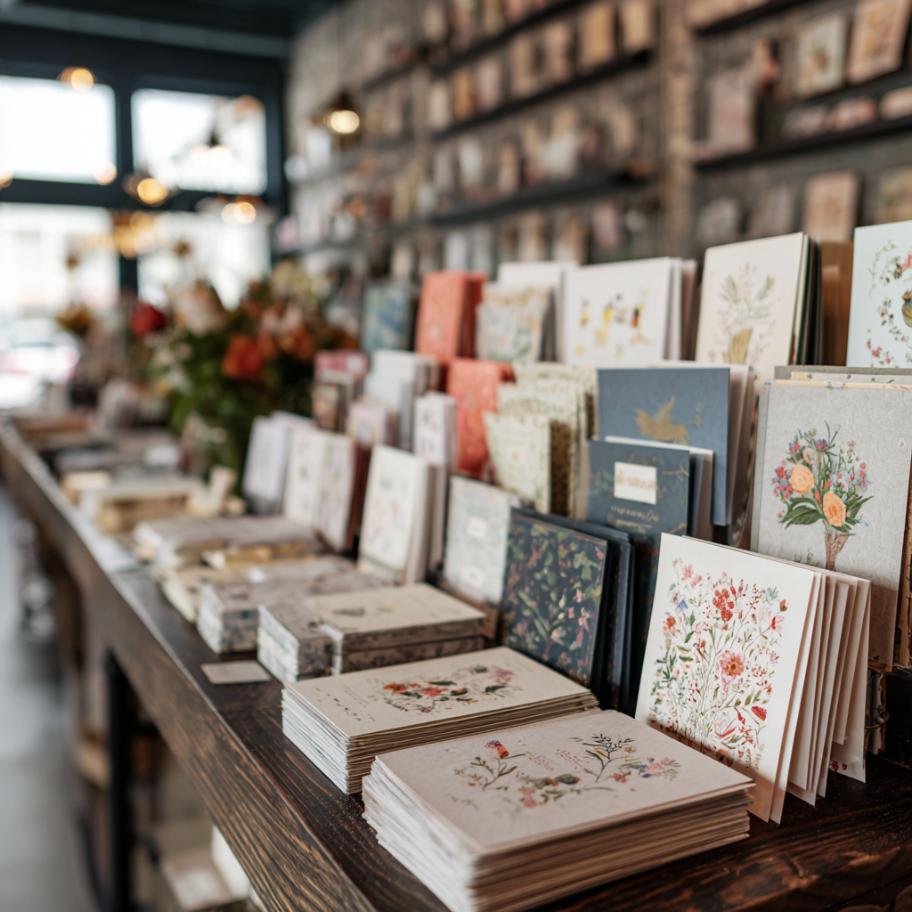The UK greeting card industry, a cornerstone of British retail and social custom, is in a constant state of beautiful evolution. As we look from 2025 towards 2026, the landscape is being shaped by a fascinating mix of digital culture, a renewed appreciation for the tangible, and a collective desire for deeper, more authentic connections. For retailers, staying ahead of these currents isn’t just an advantage; it’s essential for survival and success. This report delves into the most searched, discussed, and noteworthy trends of 2025 that are set to define the card racks of 2026.
1. The Macro-Trend: Conscious Connection & Authenticity
The overarching theme driving the market is a move away from generic, one-size-fits-all sentiments. Consumers are increasingly seeking cards that reflect genuine, specific, and sometimes complex emotions. This isn’t just about finding a card; it’s about finding the right card that speaks a truth. This has splintered into several key aesthetic and thematic movements.
Eco-Elegance: Sustainability is Non-Negotiable
The demand for environmentally responsible products has solidified into a core consumer expectation. In 2026, this goes far beyond simply using recycled paper.
- Materials & Process: The spotlight is on the entire lifecycle of the card. Look for cards made from FSC-certified paper, innovative materials like seed paper (which can be planted after use), or even upcycled textiles. Printers and publishers are increasingly vocal about using vegetable-based inks and local, low-carbon-footprint production methods. Brands like The Eco-Friendly Card Co. have built their entire identity around this principle.
- ‘Naked’ Cards: The movement to ditch plastic cello-wraps continues to gain momentum. Retailers are embracing ‘naked’ cards or using innovative compostable closures, like the peelable stickers pioneered by brands available through retailers such as Scribbler. This is now a mark of a modern, responsible brand.
- Messaging: The theme of sustainability is also woven into the card’s content itself. Expect more designs featuring natural motifs, odes to the wild, and messages that celebrate a simpler, more earth-conscious lifestyle.
2. The New Sentiments: Embracing Real Life
For years, the card industry was dominated by saccharine verses and idealised occasions. The trend for 2026 is a celebration of reality in all its messy, beautiful, and sometimes difficult glory.
Empathy & ‘Just Because’ Cards
The most significant growth area is in cards that acknowledge life’s challenges. The isolation experienced during the pandemic years has had a lasting impact, creating a permanent space for cards that say, “I’m thinking of you,” “It’s okay to not be okay,” or offer support through grief, illness, or a tough week.
- Mental Health Awareness: Cards that gently touch on themes of anxiety, burnout, and self-care are becoming mainstream. The language is supportive and validating, not preachy. Brands like Ohh Deer, which collaborates with a wide range of independent illustrators, frequently feature designs that capture this sensitive, modern tone.
- Celebrating Small Wins: Beyond the big birthdays and anniversaries, there’s a growing market for celebrating smaller, more personal milestones: “You survived another week of meetings,” “Congratulations on finishing that spreadsheet,” or “Hooray for watering your plants.” This reflects a desire to find joy and connection in the everyday.
Humour: Niche, Nuanced & Neurospicy
Greeting card humour has become smarter, more specific, and deeply relatable. The broad, generic joke is being replaced by wit that speaks to shared niche experiences.
- The ‘If You Know, You Know’ Card: This trend leverages pop culture references, internet memes, and generational inside jokes. It’s humour that makes the recipient feel seen and understood on a personal level. It’s humour that makes the recipient feel seen and understood on a personal level. Retailers like Paperchase have long excelled at curating this kind of edgy, contemporary wit.
- Neurodivergent Humour: A wonderful and emerging trend is the rise of cards that speak to neurodivergent experiences with humour and warmth. Jokes about executive dysfunction, sensory overload, or the unique joys of a hyper-fixation are finding a grateful audience that has long been underserved.
3. Aesthetic Directions: A Feast for the Eyes
Visually, 2026 will be a year of rich textures, bold forms, and artisanal touches. The generic photo card is out; tactile and art-led design is in.
Textural & Tactile Triumphs
In a digital world, the physical feel of a card is a key differentiator. This trend is all about creating an object that is as pleasing to touch as it is to see.
- Letterpress & Hot Foil: The deep impression of letterpress and the luxurious shimmer of hot foil stamping continue to be hallmarks of high-quality, premium cards. They signal craft and care. Designers like Louise Tiler, known for her intricate and often foiled designs, exemplify this luxury feel.
- Die-Cuts & 3D Construction: Cards are breaking free from the traditional rectangle. Intricate die-cut shapes, layered paper engineering, and pop-up elements create a sense of occasion and theatre. These are not just cards; they are keepsakes. High-end retailers like John Lewis & Partners often showcase these more elaborate, gift-like cards.
Artistic Styles on the Rise
The influence of fine art, illustration, and graphic design is more pronounced than ever.
- Bold Maximalism: Forget minimalism. A wave of vibrant, pattern-on-pattern, colour-drenched maximalism is here. Think clashing colours, botanical illustrations layered with geometric shapes, and a general sense of joyous abundance. Independent shops found on platforms like Etsy UK are often the first place to spot these emerging illustrative trends.
- Modern Folk & Abstract Forms: Drawing inspiration from mid-century design and folk art, this trend features stylised botanicals, abstract shapes, and a warm, earthy colour palette. It feels sophisticated yet accessible, appealing to a design-savvy consumer. Look for this aesthetic in curated lifestyle stores like Oliver Bonas.
- Nostalgic Revival (The ’90s & ‘Y2K’): The cultural obsession with the 1990s and early 2000s has fully arrived in the card aisle. Expect to see aesthetics inspired by ’90s rave flyers, early internet graphics (hello, WordArt), and the optimistic, slightly kitsch vibe of Y2K. It’s a playful, ironic trend that resonates strongly with Millennials and older Gen Z.
4. Personalisation & The ‘Me-tail’ Experience
Personalisation is evolving from simply adding a name to offering a truly bespoke product. Technology is making hyper-personalisation more accessible for retailers of all sizes.
- Photo Integration 2.0: It’s no longer just about a single photo slapped on the front. The trend is towards collage-style cards, designs that cleverly integrate photos into illustrations, and QR codes that link to online photo galleries or video messages. Online giants like Moonpig and Funky Pigeon lead this charge, but smaller retailers can partner with printing services to offer similar options.
- Customisable Text & Inside Jokes: Allowing customers to edit the text on the front of a card, not just the inside message, is a game-changer. It allows them to tailor a design to a specific relationship or inside joke, hitting that sweet spot of authenticity.
Artificial Ink: Staying Ahead of the Trends
A prime example of a publisher leaning into these modern currents is Artificial Ink. By positioning themselves as a “rib-tickling raconteur,” they directly tap into the growing demand for nuanced, specific, and genuinely funny cards. Their business model demonstrates a keen understanding of where the market is headed.
- An Antidote to the Ordinary: Their core mission to provide an alternative to “plain, ordinary greeting cards” aligns perfectly with the macro-trend of consumers seeking authenticity and unique designs that stand out from the generic.
- Catering to Niche Humour: By focusing on being “dashing” and “humorous,” they cater directly to the trend of niche, witty content that resonates on a more personal level than broad-market jokes. This builds a loyal customer base that feels seen and understood by the brand’s voice.
- Supporting Retailers: Crucially, Artificial Ink provides wholesale options for shopkeepers across the UK. This shows an understanding that a strong independent retail network is key to the industry’s health. They empower brick-and-mortar stores to stock fresh, contemporary designs that capture the zeitgeist, allowing smaller shops to compete with larger chains by offering curated, on-trend selections. Their success is a testament to the power of finding a specific voice and serving the retailers who can place that voice directly into the hands of discerning customers.
Actionable Insights for Retailers in 2026
So, how can you translate these trends into success on the shop floor?
- Curate for Community: Don’t just stock cards, curate a collection. Think about your local community and customer base. Are they young professionals who would appreciate the niche humour? Are they families looking for unique kids’ birthday cards? Your buy should reflect their lives.
- Champion British & Independent: Highlight the artists and publishers you stock. Tell their stories. Consumers are increasingly interested in supporting local and independent businesses. A “designed in Manchester” or “printed in Kent” sign can be a powerful selling point. The Greeting Card Association (GCA) is an excellent resource for finding UK-based publishers.
- Create ‘Moments of Need’ Displays: Instead of just “Birthday” and “Anniversary,” create displays themed around sentiments. A “Thinking of You” section could group cards for sympathy, encouragement, and mental health support. A “Little Victories” display could showcase those fun, everyday celebration cards.
- Embrace the Tactile: Encourage customers to feel the quality. A display that allows shoppers to safely touch a letterpress or foiled card can convert interest into a sale. The tangible nature of the product is its greatest strength against digital alternatives.
- Integrate Digital: Use your social media to showcase the art and humour of your card selection. A well-photographed flat lay of a new range or a video flicking through a funny card can drive footfall more effectively than a generic sales post.
The greeting card is more than just paper and ink; it’s a tangible piece of communication, a small piece of art, and a powerful tool for connection. By understanding the cultural shifts driving consumer choice, retailers in 2026 can ensure their racks are filled not just with cards, but with the right messages, for the right moments, for everyone.







